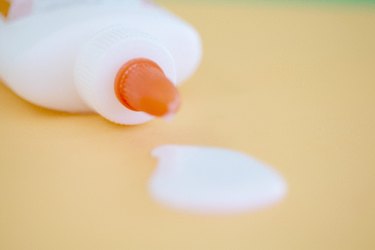Things You'll Need
Acrylic paints
Paintbrushes
Water base, such as a small depression, waterfall frame or other base
PVA glue
Plaster powder
Blue and green food coloring

PVA glue is everyday household glue or craft glue, often used by children. This white glue dries to a transparent finish, which makes it ideal for creating ponds, oceans and rivers for hobby terrain, such as for train modeling or school projects. Mixing the glue with different materials will create different textures that can make the water almost appear as if it is moving like real water. Experiment with different additives and textures to get the water look you want.
Smooth Water
Step 1
Paint the inside of the water base to look like the base of a pond. You can use browns, blacks, blues or greens to make the base look like your specific type of water. For dirty water or rivers, use browns and blacks. For clean water, use blues. For swamps use a green base. Allow the paint to dry overnight.
Video of the Day
Step 2
Mix three parts glue and one part water together in a small bowl. Add a few drops of blue or green food coloring to make clean water, or you can leave the mixture without food coloring for a more transparent pond or to make foaming water.
Step 3
Pour the glue into the water base to a thickness of about ½ inch. Allow the glue to dry for 72 hours. Continue adding ½-inch layers of glue until the depression is full. When the glue is half dry, speckle the top of the glue with a paintbrush to create texture on the water.
Textured Water
Step 1
Mix one part glue with one part plaster powder. Mix the two materials together until the powder dissolves.
Step 2
Paint the mixture onto the water where you want to add texture, such as foaming around rocks, waves or at the base of waterfalls.
Step 3
Allow the mixture to dry until nearly hard. Speckle the surface of the foam with a paint brush. Allow the mixture to dry completely. Repeat this process two more times to create depth in the foam water.
Video of the Day